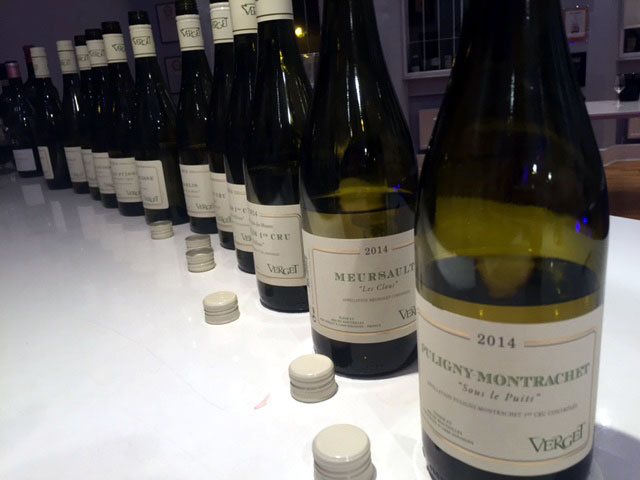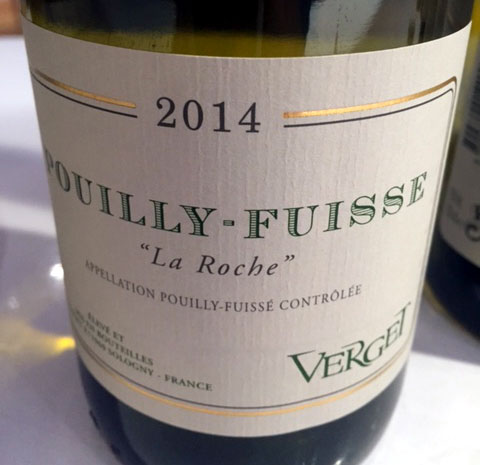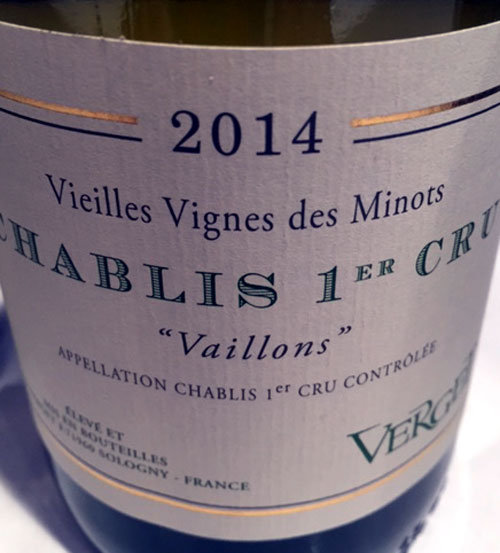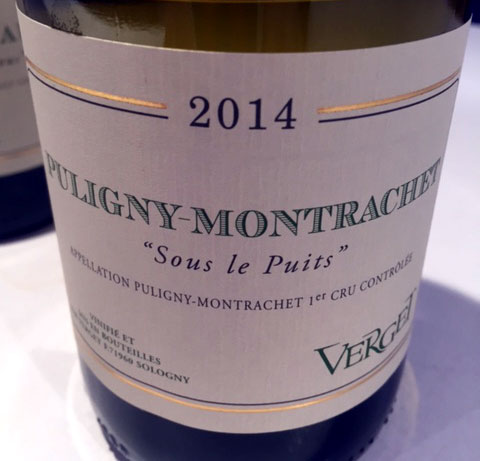As most Farr Vintners customers will know, we have been importing and championing the White Burgundies of Jean-Marie Guffens and his negociant house Verget for many years. In fact, it was over 20 years ago now that I first visited his winery in the sleepy village of Sologny and met this eccentric, slightly bonkers - but undoubtedly genius - winemaker. His wines had been brought to our attention initially by some rave views for the amazing 1992 vintage and they really were outstanding (and still are - if you can find them). We bought all that we could from this year and have shipped every vintage produced ever since.
Jean-Marie was one of the first Burgundian winemakers to identify, and take seriously, the issue of premature oxidation and the problems of cork taint. Other producers (including some really famous Domaines) adopted a “head in the sand “policy despite countless bottles of their wines being poured down sinks around the world. He has, for many years, offered his customers the choice of stelvin screwcaps, plastic nomacorcs, composite corks and regular corks. Farr Vintners had the whole of our allocation of the 2003 vintage bottled under screwcap – even Corton Charlemagne - and have had the vast majority of our purchases sealed under screwcap ever since. I’m pleased to report that the problems that still plague other top producers have not troubled Verget since then.

Line up of 2014 Verget White Burgundies
|
When we first tasted barrel samples of the 2014s, early this year, it was pretty clear to us that this is an excellent White Burgundy vintage. It’s certainly the best year since 2010 and potentially even better. Healthy grapes have produced wines that are fresh and balanced but a little plumper than the lean 2010’s and a little brighter than the looser-knit 2012’s. Yields were quite small - which has resulted in concentrated, balanced wines with ripeness and acidity in perfect harmony and moderate alcohol levels.
Consequently, we made a large purchase of Verget 2014’s from vineyards across the Burgundy region from Macon in the South to Chablis in the North. All the wines are now bottled (with screwcaps) and have recently been shipped to Octavian’s warehouse in Corsham. We assembled bottles of all the wines that we bought and tasted them on Friday 20th November.
First up were the wines from the Maconnais region:
Macon Bussiere Montbrison
This parcel of vines is located close to the villages of Vergisson and Pouilly Fuissé with an Eastern exposure. The soil is clay and limestone with many stones and the vines average over 40 years of age. The grapes were very healthy and harvested late. Vinification of the free-run juice was all in barrel with 15% new oak. Fermentation continued to mid-February with elevage in barrel continuing for a further 5 months with regular batonnage. Plump, fleshy and generous with sweet melon notes. Succulent but clean and refreshing. An excellent start and quite a bargain to get a White Burgundy of this quality at under £100 per dozen. Drink it now or hold for a year or two. No need to wait. 15.5
Macon Vergisson La Roche
This parcel of vines is located at the top of the Roche de Vergisson and is surrounded by plots entitled to the Pouilly Fuissé appellation. Free-run juice was vinified all in barrel of which 15% was new oak. After fermentation there was a further 6 months barrel-ageing with regular lees stirring. This is slightly paler in colour and more intense and complex with a smoky nose, excellent minerality and a touch of toasty oak. There is lovely minerality at the core of this wine. Poised and focussed with tension and acidity. Less of a crowd-pleaser than the Bussieres but ultimately a more serious wine for the cellar. 15.5+
Saint Veran Vigne de Sainte Claude
This parcel of vines is located in the village of Prissé, close to the Pouilly Fuissé vineyards of Vergissson. The vineyard is very stony with a clay and limestone soil. The vines average 50 years of age. Made only from free-run juice that was fermented and then aged for a further six months in oak barrels of which 20% were new. This has a lovely perfumed nose of melony fruit and a hint of creamy vanilla. There is lovely structure here and a mineral heart behind the opulent facade. Impressive volume and density with a full body but, at the same time, it is fresh, lively and complex. 15.5+

Saint Veran Vigne de Sainte Claude
|
Saint Veran “Lieu Interdit”
This comes from the Côte Rôtie vineyard whose name is no longer allowed to be shown on the label. The vines are in the village of Davayé but with the same soil as Pouilly Fuissé La Roche. This magnificent terroir has a shallow limestone soil with a southern exposure. The yield in 2014 was just 25 hl/ha. The wine was produced from free-run juice only and vinified in barrels, of which 25% were new. Fermentations continued until December and this was followed by barrel elevage for a further 7 months with lees stirring every week. Nutty and rich on the nose. Fleshy, juicy and full-bodied but vibrant acidity too. Slightly closed at this stage but definite promise. It should open up with a bit of time in the cellar. Clearly very good but not quite singing today. 16
Pouilly Fuissé Terroirs de V…….
This wine has been labelled as "Terroirs de V" due to an ongoing change in the ranking system of vineyards in Pouilly Fuissé, but it is from the same parcels of vines in Vergisson as usual. Elevage is similar to the two single vineyard wines with a little less new oak. Big, fat, rich, plush and juicy. This is textbook Pouilly Fuissé. Notes of lemon curd and toast and impressive depth. An opulent White Burgundy that can be enjoyed in its youth – although I’m sure that it will age well too. 16.
Pouilly Fuissé Les Combes VV
The vines in this vineyard average over 70 years of age. The wine was fermented in barrels of which 25% were new. This was followed by a further 7 months barrel ageing. The regular Pouilly Fuissé is good but this is a serious step-up for not much more money! Certainly one of the stars of today’s tasting. Very sexy and oily with real volume and density. Serve this blind as a Premier Cru Meursault and you’ll get no complaints! Seriously layered and textured with exotic ripeness but a flinty, mineral purity gives balance. A long, enduring finish. Really impressive. 17.
Pouilly Fuissé La Roche
The La Roche vineyard in Vergisson has a south-east exposure and a soil rich in limestone. It gives wines that are both mineral and rich. This wine was fermented entirely in barrels of which 25% were new. Elevage for a further 7 months in barrel before being transferred to concrete tanks on fine lees. Jean-Marie is particularly proud of this wine in 2014. This one of the top terroirs of the region and in 2014 it certainly doesn’t disappoint. Fat and generous with lots of plump, fleshy ,ripe, peachy fruit. Wonderful ripeness with zingy minerality. Maybe not quite as intense as the Combes and will benefit from a little time in bottle. There is no doubt that this is a top Pouilly Fuissé. 16.5++

Pouilly Fuissé La Roche
|
We then moved considerably further North to Chablis. We’ve not tasted a lot of 2014 Chablis yet, but Neal Martin had already whetted our appetites by declaring in The Wine Advocate “I absolutely adore the 2014 vintage in Chablis! It is bursting with youthful energy and tension. It ticks the boxes of what Chablis ought to be and moreover, the facets and virtues that make Chablis different from anywhere else.”
Chablis Cuvée de la Butte
This parcel of vines is situated in the village of Chablis close to the Premier Cru vineyard "Les Butteaux". It has a south-eastern exposure with a calcareous soil and a very abrupt slope. The yields are low. The free run juice was vinified in horizontal stainless steel tanks with elevage on fine lees and with regular stirring. No oak at all. Very fresh and zesty. So bright that it’s almost got a grassy Sauvignon style. Stony, flinty, clean, lean, as fresh as a daisy. Real purity. If you want a wine that screams Chablis then this is it. 16.
Chablis 1er Cru Côtes de Lechet
This steep south-facing vineyard has naturally low yields and was picked relatively early, in mid-September, to avoid over-ripeness. Completely fermented and matured in horizontal stainless steel tanks. Likewise, this is citric and intense with great minerality and acidity. A wine that would be perfect with oysters and other seafood. Crisp and breezy. 16.5
Chablis 1er Cru Mont de Milieu
This wine has been elevaged in oak so is more opulent and creamy than the other Chablis wines. Very different in style. On the nose there is Chablis flint but hints of toasty vanilla oak too. The palate is surprisingly opulent and creamy for a Chablis and, at this early stage in its life, the oak dominates a little too much. However, it will no doubt settle down in the bottle and give great pleasure in the future – especially to those who don’t like their Chablis on the lean side. 16++
Chablis 1er Cru Vaillons Vieilles Vignes
This is made from grapes grown in a small vineyard called "Les Minots" within the Premier Cru vineyard of Vaillons. The vines are over 50 years old and the yield was a meagre 25 hl/ha. The free run juice was vinified in barrels with less than 10% new because of the high density of the wine. When fermentations were completed in late December, the wine was transferred to concrete tanks where it was aged on fine lees for a further 7 months. This is top class! A lovely precise purity to the nose. Classically Chablis with stony notes but exuberance too. The palate is beautifully layered and packed with flavour and ripeness but with a firm cut of vibrant acidity. Long and serious – this really lingers on the finish and the touch of oak that was used to ferment is un-noticeable. Impressive density but taut, precise, linear and very long. 17+

Chablis Vaillons Les Minots VV
|
We then moved back South, to finish in the Côtes de Beaune and the two classic villages of Meursault and Puligny. These last two wines were very good but don’t be fooled into thinking that the higher prices for these famous names mean that they are necessarily better than the wines that we tasted before them.
Meursault “les Clous”
This "lieu-dit" vineyard is situated at the top of the village of Meursault. Produced from free-run juice only and all fermented in barrels (of which one third were new). Elevage continued in barrel for a further 8 months with lees stirring every week. Lots of toasty oak on the nose here. Generous, fat and plump. Rich and fleshy on the palate. Typically Meursault and it will not disappoint those who want a famous name at a fair price. Personally I found more excitement and tension in the top Chablis and Pouilly Fuissé wines, but this is a winning Meursault that delivers exactly what you expect. 16.5
Puligny Montrachet 1er Cru “Sous le Puits”
This Premier Cru vineyard is situated at the top of the village of Puligny, near to Blagny, and is the highest point of the appellation. Grapes were picked late and the free run juice was vinified in oak barrels of which 25% were new. Fermentations were completed in late January and then the wine was aged in barrel for a further six months with weekly lees stirring. Now this is a step-up in quality! The colour is a bright shiny light gold. The nose is smoky and complex, intense and refined. There is great elegance here to this classic White Burgundy. It is at once steely, mineral and crisp yet full-bodied and dense with power and precision in perfect harmony. Long and lingering on the finish. Ripe fruit, vanilla oak, minerality and acidity all in balance. Top class. 17+

Puligny Sous le Puits
|